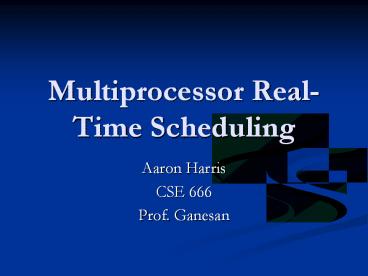Multiprocessor Real-Time Scheduling PowerPoint PPT Presentation
Title: Multiprocessor Real-Time Scheduling
1
Multiprocessor Real-Time Scheduling
- Aaron Harris
- CSE 666
- Prof. Ganesan
2
Multiprocessor Scheduling
- As more systems incorporate multiple processors,
interest in scheduling algorithms increases. - Still relatively little research done (compared
to uniprocessor scheduling). - Due to increased complexity, much research makes
simplifications of their systems.
3
When and Where
- Multiprocessor scheduling requires determining
both which task to run at a given time and on
which processor to run it on. - Added complexity as compared to scheduling in a
uniprocessor environment. - Scheduling must account for not only the status
of tasks, but the status of processors.
4
Schedule Management
- In a standard system, the schedule is controlled
by the processor. - Multiprocessor systems follow two general
approaches master-slave and dedicated scheduler. - In master-slave, one processor handles all
schedule processing and also processes normal
tasks. - Dedicated scheduler systems allocate an entire
processor to nothing but schedule processing.
This can be more efficient in complex systems
with many processors.
5
Algorithm Selection
- In a single processor system, rate-monotonic (for
static priorities) and earliest-deadline-first
(for dynamic priorities) algorithms are the
accepted best overall algorithms. - There is no agreed-upon best algorithm for
multiprocessor systems (due to increased
complexity of algorithms and lack of research).
6
Algorithm Categories
- Most multiprocessor scheduling algorithms fall
into one of two categories global scheduling and
partitioned scheduling.
7
Partitioned Scheduling
- All tasks are divided among the processors at
compile time. - Each task can only execute on its assigned
processor. - Advantages This turns each processor into a
single processor system as far as scheduling is
concerned. All research and theory of single
processor scheduling then applies to each
processor. - Disadvantages The process of assigning tasks to
processors can be complicated and extremely
inefficient if done poorly. This can lead to
poor system performance.
8
Global Scheduling
- All tasks are allowed to execute on all
processors. - Tasks are scheduled from a global queue to
individual processors. - Advantages This technique allows for better
processor utilization and overall system
performance. - Disadvantages The main disadvantage is
migration. This is when a task is preempted on
one processor and resumes execution on a
different processor. This requires the context
of the task to be moved from one processor to
another, which can be costly.
9
Problems Dhalls Effect
- Something interesting is the relation of
ultization to scheduliblity. - One may think that to be schedulable, the
utilization of a set of tasks on n processors
should simply be n. - Dhall proved that the number must actually be
between nln(2) and n (Dhalls Effect).
10
Problems Schedule Complexity
- Many types of scheduling (e.g. dynamic
priorities) that require extensive run-time
calculations can become too complicated in a
multiprocessor environment. - Due to this, most of the scheduling algorithms
that have been researched use compile-time
determined priorities.
11
Problems Resource Synchronization
- Resource synchronization becomes a much larger
issue in multiprocessor systems. - Even in a non-preemptive multiprocessor system,
resource sharing can lead to task blocking. - More thought must be put into how and what
resources are shared between tasks in a
multiprocessor system.
12
Conclusions
- Multiprocessor scheduling algorithms are more
complex than uniprocessor systems. - There is still no decisively best multiprocessor
scheduling algorithm. - Multiprocessor systems will continue to become
more and more prevalent, and as a result,
multiprocessor scheduling research and theory
will have to continue to improve.
13
References
- Khemka A., Shyamasundar R. K., "An Optimal
Multiprocessor Real-Time Scheduling Algorithm",
Journal of Parallel and Distributed Computing 43,
37-45, 1997 http//citeseer.ist.psu.edu/khemka97op
timal.html. - G. Manimaran, C. Siva Ram Murthy, "An Efficient
Dynamic Scheduling Algorithm for Multiprocessor
Real-Time Systems," IEEE Transactions on Parallel
and Distributed Systems, Vol. 09, No. 3, pp.
312-319, March, 1998. - K. Ramamritham, J.A. Stankovic, P.F. Shiah,
"Efficient Scheduling Algorithms for Real-Time
Multiprocessor Systems," IEEE Transactions on
Parallel and Distributed Systems,
Vol. 01, No. 2, pp. 184-194, April, 1990. - J. Carpenter et al., A Categorization of
Real-Time Multiprocessor Scheduling Problems and
Algorithms, http//www.cs.uga.edu/shelby/pubs/ca
rpenterFHSAB2003.pdf. - S. K. Dhall, C. L. Liu, On a Real-Time
Scheduling Problem, Operations Research, Vol.
26, No. 1, Scheduling (Jan. Feb., 1978), pp.
127-140.
14
Questions?

